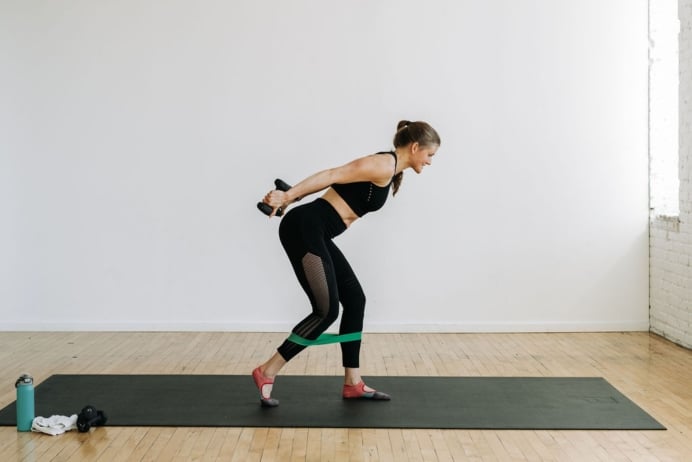
7 Best Strength Training Exercises
This 30-minute home workout combines the most effective strength training exercises for women into a dynamic, full-body routine. Using compound movements that engage the lower body, upper body and core, each exercise is designed to build strength at home. Ideal for busy women looking to build lean muscle, boost metabolism and burn fat, all you need is a set of dumbbells to get a challenging, results-driven workout from home.
I’m a huge advocate for strength training (also known as resistance training) because it’s one of the most effective and empowering forms of exercise you can do. Strength training simply means using resistance (like dumbbells, resistance bands or even your own bodyweight) to challenge your muscles, helping them grow stronger and more resilient over time.
For women, especially, incorporating regular strength training is a game-changer. In the past, many women were told to stick to cardio or avoid lifting weights altogether. But the science is clear: strength training is essential for building lean muscle, maintaining bone density and supporting long-term health. The best strength training for women focuses on compound exercises or movements that work multiple muscle groups at once, such as squats (to strengthen the legs and glutes for climbing stairs or hiking), push-ups (to improve upper body strength for lifting groceries or carrying kids) and rows (to build back muscles that help with posture and prevent neck or shoulder pain).
This is especially important for women over 50. Muscle mass naturally begins to decline around age 30, and that loss accelerates after menopause. Strength training is one of the most effective ways to slow this process, protect joint health, improve balance and reduce the risk of osteoporosis. Plus, it boosts metabolism, making it easier to maintain a healthy weight as we age.
The best part? Strength training doesn’t have to be expensive or complicated. You can do an incredibly effective workout at home with nothing more than a pair of free weights… or even just your bodyweight. This 30-minute follow-along home workout combines the most effective strength moves into a full-body routine, so you’ll target your lower body, upper body and core in one session. This at-home weight training routine will help you feel stronger and more capable in everyday life.
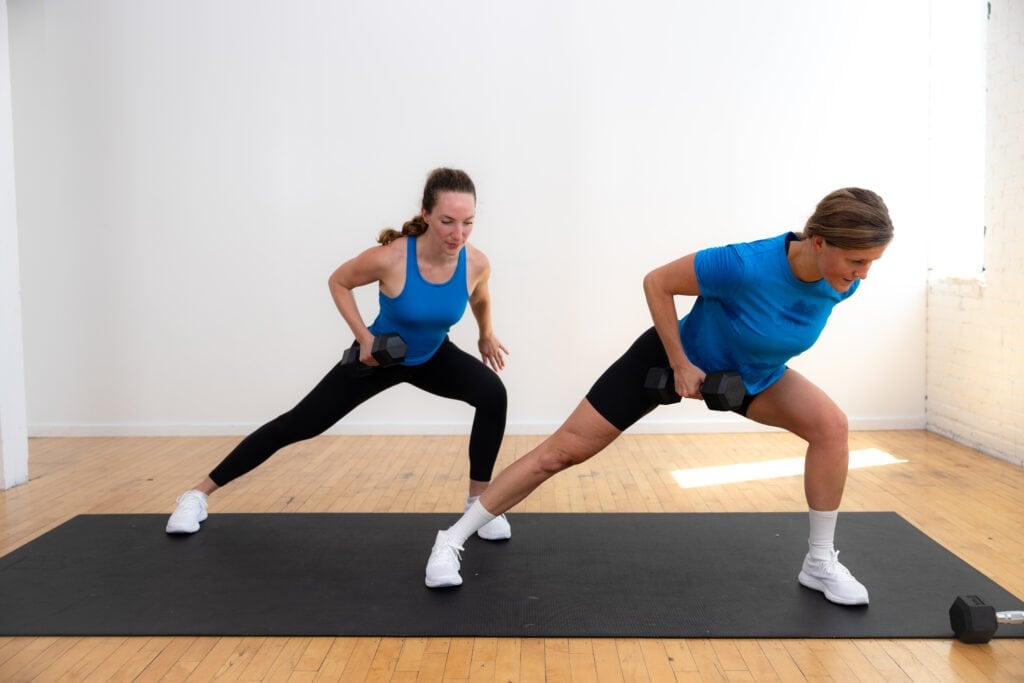
Read A 5-Star Review ⭐⭐⭐⭐⭐
“I always use your workouts when I need something from home! As a physical therapist, I LOVE how you incorporate the multiplanar movements/single-sided weight for the core!!”
— Alyssa C.
Workout Details
Build full-body strength with this strength training routine for women. 7 of the best compound strength training exercises combined in a challenging and effective 30-minute workout.
This strength workout has been my go-to through all seasons of life, including pregnancy and postpartum. You decide how challenging it is based on the weights you pick up.
Add this full-body strength-building workout for women to your home training program 1-2 times a week to build muscle and increase endurance.
Workout Equipment:
Medium to Heavy Set of Dumbbells. I recommend between 5-25 lbs depending on your fitness level. We used 10, 15 and 20 lb dumbbells in today’s workout. The goal is to fatigue your muscles by the end of each set – you should struggle to complete the last 2-3 reps with correct form. That means you chose challenging weights.
Option to drop weights at any time and do this workout with just your body weight.
Workout Instructions:
Follow along with the guided Weight Training For Women Workout on YouTube, led by me — your certified personal trainer, Lindsey Bomgren.
Your Workout Looks Like This:
- Guided Warm-Up and Cool-Down
- 7 Strength Training Exercises
- Timed Intervals (45 seconds of work, 15 seconds rest; complete as many repetitions as you can in the timed interval)
- Repeat All 7 Exercises x3 Sets (taking a 1-minute break between sets)
Note: Today’s dumbbell workout routine is an updated version of a popular strength training workout. I re-filmed this workout to improve the audio and video quality and share some new moves. If you try both, I’d love to know which version is your favorite!
Workout Outline
1. Front Squat and Overhead Shoulder Press
Targets: Glutes, quads, hamstrings, shoulders (rotator cuff and anterior deltoid) and core.
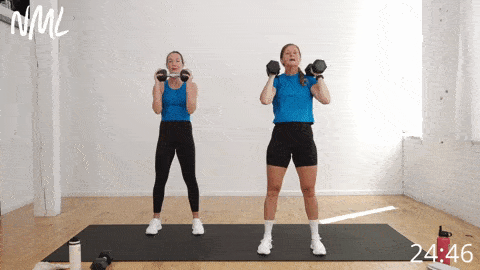
How to Do a Front Squat and Overhead Shoulder Press
- Stand with your feet shoulder-width apart and your toes pointing straight ahead or slightly angled out away from your body.
- Hold one dumbbell in each hand at your shoulders (palms facing in) and exhale to engage your core.
- Lower your hips down into a front squat, aiming to get your thighs parallel to the ground. Keep your weight in your heels, elbows and chest up.
- Drive through your heels to stand tall and perform an overhead shoulder press by pressing both dumbbells overhead, locking out your biceps by your ears.
- Lower the dumbbells back to your shoulders and repeat the squat to overhead press.
Modification: Hold one dumbbell horizontally at your chest, or perform the movement as a bodyweight exercise.
2. Alternating Reverse Lunge and Bicep Curl
Targets: Biceps, quads, hamstrings, glutes and core.
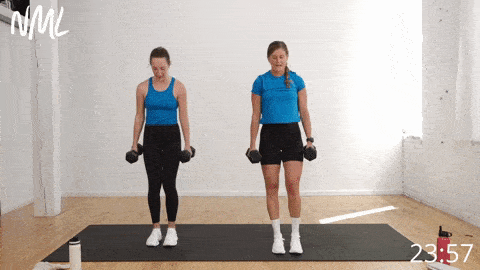
How to Do an Alternating Reverse Lunge and Bicep Curl
- Stand with your feet hip-width apart. Hold a dumbbell in each hand at your sides, palms facing in towards each other (hammer grip).
- Step your right leg back into a reverse lunge, dropping your right knee down towards the ground as you lower your hips until both knees reach a 90-degree angle, front thigh is parallel to the floor.
- Hold the bottom of your lunge as you bend your elbows to curl the dumbbells up towards shoulder height, performing a hammer grip bicep curl.
- Slowly lower the dumbbells back down to the starting position. As you lower the dumbbells, exhale, squeezing your left glute and keeping your weight in your left heel as you drive through the heel to stand tall, returning to your starting position.
- Repeat the lunge on the left side by stepping your left foot back into a reverse lunge, dropping your left knee down towards the ground until both knees reach 90-degree angles. Hold the lunge as you perform a hammer curl.
- Exhale, squeezing your right glute to push you up as you return to the starting position.
Modification: If lunges are uncomfortable, check out these alternative exercises.
3. Deadlift and Upright Row
Targets: Hamstrings, glutes, upper back, shoulders and core.
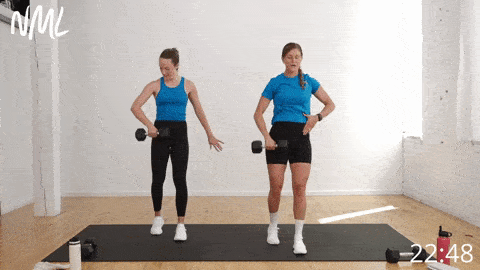
How to Do a Deadlift and Upright Row
- Stand with your feet hip-width apart, holding a dumbbell in your left hand with your palm facing in towards your body.
- Stagger your feet so your right leg is slightly in front of your left foot. Kickstand your back left foot, left heel floating off the ground. Keep 80% of your weight in your front foot, 20% in your back toes.
- Maintain a staggered stance as you hinge at the hips. Push your hips back towards the wall behind you as you glide the dumbbell down the front of your leg, until you feel a stretch in the back of your leg. This is a deadlift.
- Press through your front heel to push your hips forward, pulling the dumbbell back up towards your hips as you stand tall.
- From a standing position, pull your left elbow up towards your left shoulder, gliding the dumbbell up your body. This is an upright row.
- Lower the dumbbell to the starting position and repeat.
4. Lateral Lunge and Single-Arm Back Row
Targets: Gluteus medius (the outer part of your butt used for side-to-side movements), quads, hamstrings, hip adductors, hip abductors, hip flexors, calves, back, biceps and core.

How to Do a Lateral Lunge and Single-Arm Back Row
- Stand with your feet under your hips, holding a dumbbell in your left hand.
- Step your right leg out to the side as you push your hips back, bending your right knee while leaving your left leg straight. Think of performing a single-leg squat with your right leg while your left leg remains straight. Knees and toes are pointing forward.
- Hold at the bottom of the lateral lunge, then pull your left elbow back towards your left hip, performing a single-arm row. With control, lower the dumbbell back to the starting position.
- Drive off your right foot to reverse the movement, stepping back to center.
5. Push-Up and Side Plank Hold
Targets: Chest, shoulders, triceps, back, abs and core muscles.
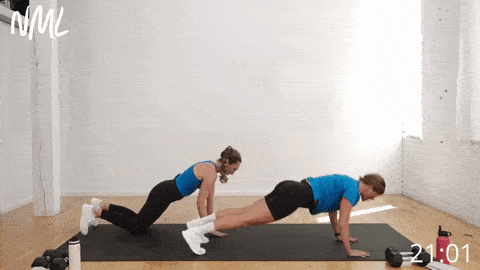
How to Do a Push-Up and Side Plank Hold
- Start in a high plank position with your shoulders stacked over your wrists, weight evenly distributed amongst all 10 fingers. Pull your kneecaps up towards your belly, feet hip-width apart.
- Slowly lower your chest down towards the ground as your elbows fall back towards your hips.
- Once at the bottom of your push-up, exhale as you push back up into high plank position.
- Pull your right arm up and over your body, opening up to your right as your arms expand into a “T” shape, performing a side plank. Hold for a 3-count before returning to high plank position.
- Repeat, performing another push-up and then opening to the left, performing a side plank on the left side.
Modification: If you experience wrist pain during push-ups, you can substitute incline push-ups by placing your hands on a chair or bench. You can also drop to your knees for modified push-ups and planks.
6. Glute Bridge and Tricep Extensions
Targets: Glutes, hamstrings, inner thighs, triceps (back of the arm) and core.
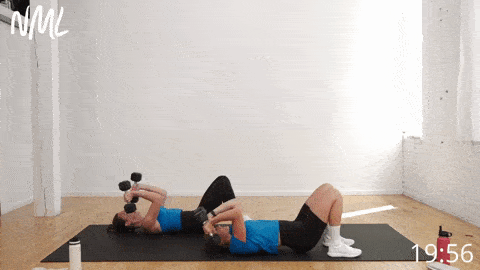
How to Do a Glute Bridge and Tricep Extension
- Lie flat on your back with your legs bent at 90 degrees and your heels flat on the ground.
- Holding one dumbbell in each hand, fully extend your arms so the dumbbells are directly overhead, palms facing one another.
- Bending at the elbows, slowly lower the dumbbells towards your head.
- As you push the dumbbells back overhead to return to the starting position, simultaneously drive through your heels, squeezing your butt to lift your hips up toward the ceiling. Keep your knees in line with your hips.
- Hold at the top for a moment, then lower your hips back down to a hover position as you lower the dumbbells back towards your head.
7. Glute Bridge Hold and Chest Press
Targets: Glutes, thighs, hips, hamstrings and chest muscles.
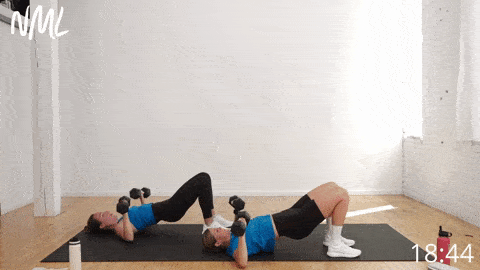
How to Do a Glute Bridge Hold and Chest Press
- Lie flat on the ground with your back straight and your legs bent at 90-degrees. Heels are flat on the ground.
- Holding one dumbbell in each hand, fully extend your arms so the dumbbells are directly overhead, palms facing away from your body.
- Drive through your heels, squeezing your butt to lift your hips up toward the ceiling. Perform an isometric hold at the top of your glute bridge.
- Bending at the elbows, slowly lower the dumbbells towards your chest. Keep your chest puffed out and the weights in line with your nipples, bending your arms at 90 degrees.
- Exhale, pushing the dumbbells back overhead to return to the starting position.
FAQs
I recommend that beginners start weightlifting 2-3 days a week. This promotes strength and muscle gains while allowing your body proper time to recover between training sessions. More advanced lifters might follow a 5-day training split, but be sure to avoid overtraining by incorporating rest and recovery. If you’re a runner who is interested in incorporating strength training, try a hybrid strength and run workout plan and find guidance here on whether to prioritize cardio over strength training.
The reality is that lifting weights will not make women bulky. “Bulking” is difficult and requires extra calories, genetics and a really intentional and consistent muscle-building routine. Women will not get bulky by focusing on strength training with moderate weights and higher repetitions. Incorporate bodyweight exercises along with functional dumbbell training, and prioritize a balanced diet with protein. This will lead to lean muscle development and that “toned” look.
Yes, strength training is generally safe during pregnancy, especially if you’ve been active and strength training prior to pregnancy. Strength training can help manage weight gain, reduce back pain and prepare the body for labor. I recommend following a pregnancy-friendly workout plan that includes appropriate modifications. Be sure to consult with your healthcare provider before starting or continuing any exercise program during pregnancy.
Beginners should focus on building a solid foundation. It’s important to work on proper form during strength training exercises, so it may be best to start with bodyweight exercises and gradually introduce weights as you advance. I recommend following a well-rounded strength training plan for women that targets every muscle group (total body, upper body and lower body) and includes strength training workouts, cardio and mobility. Progressively increase the intensity of your workouts, and be sure to incorporate rest days for muscle recovery and growth.
More Workouts
Strength TrainingPin This Strength Training Exercise Roundup
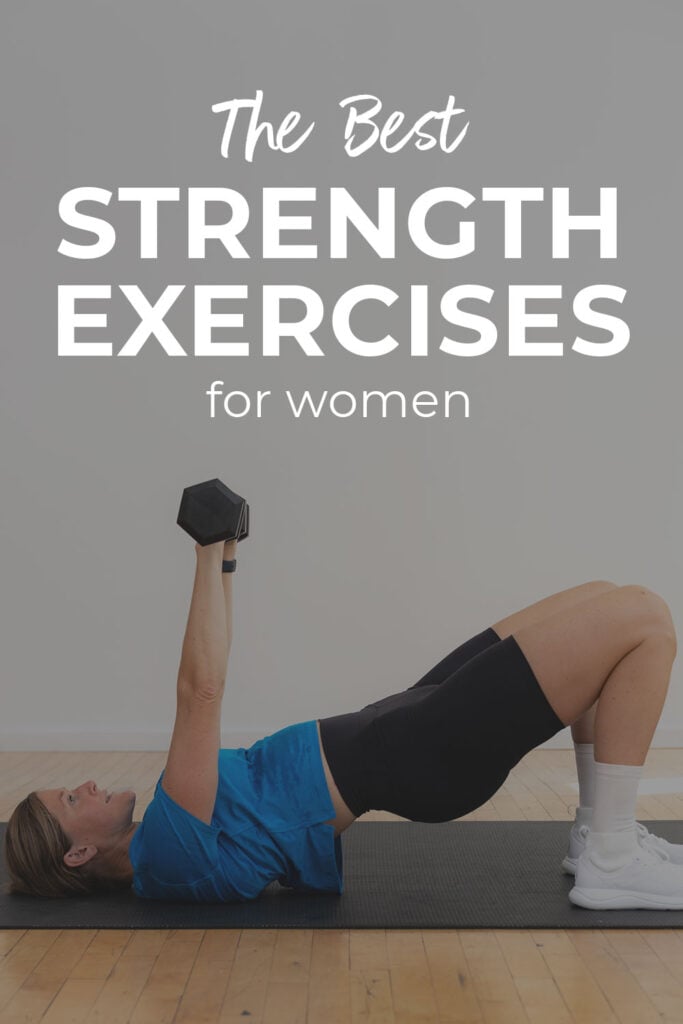











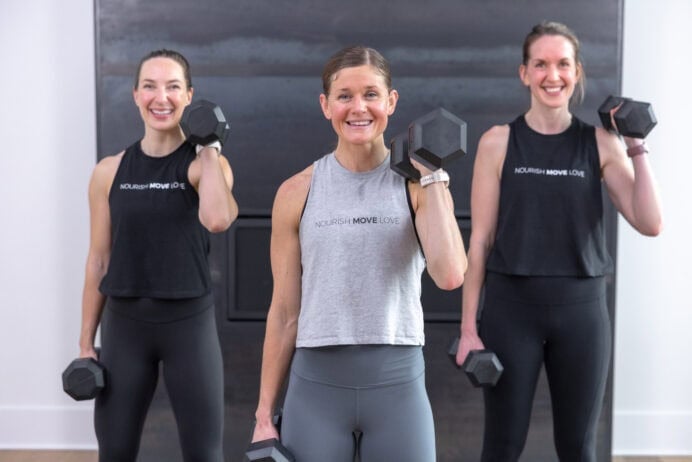
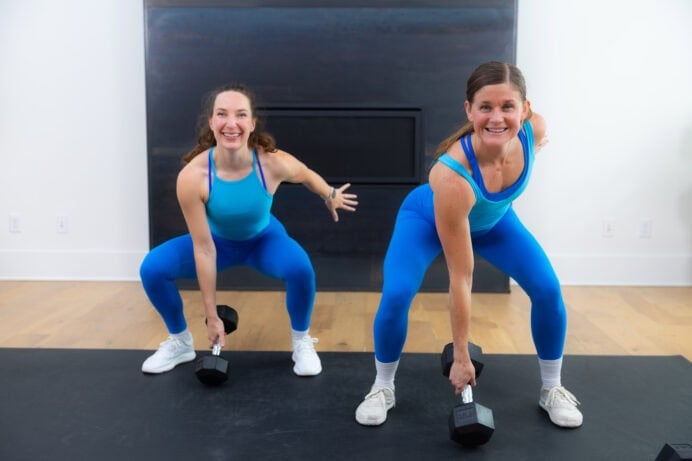
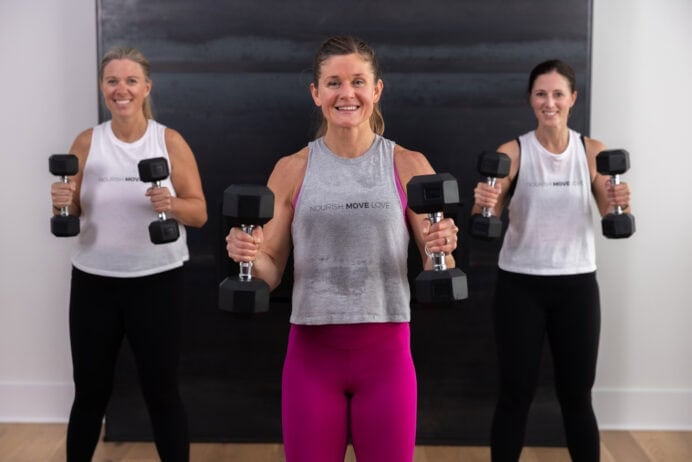
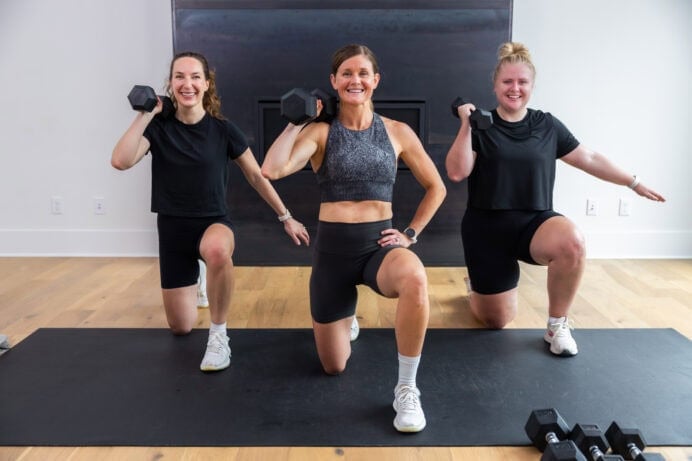
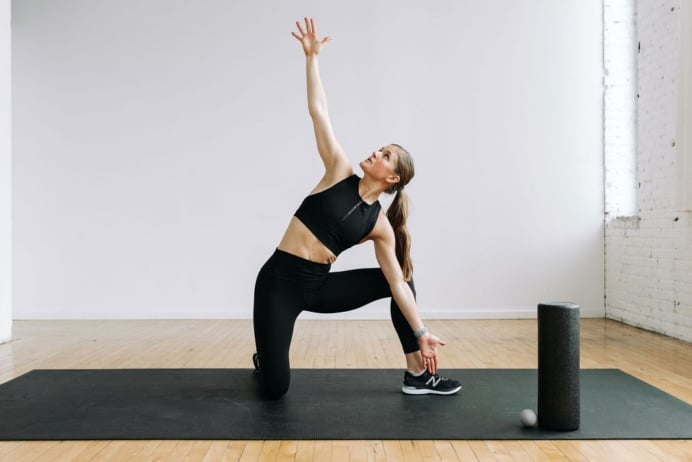
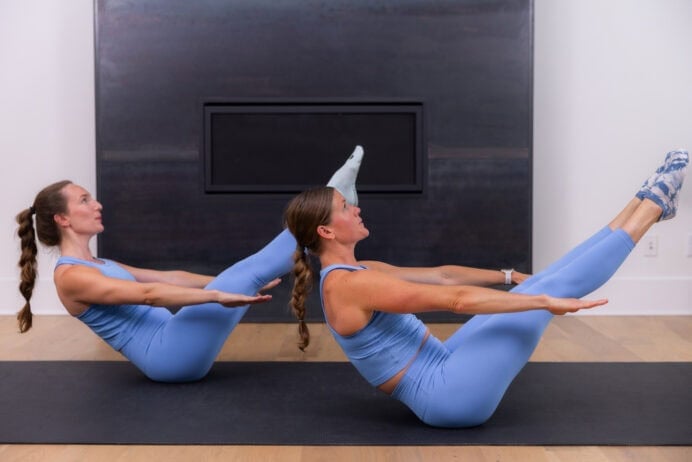
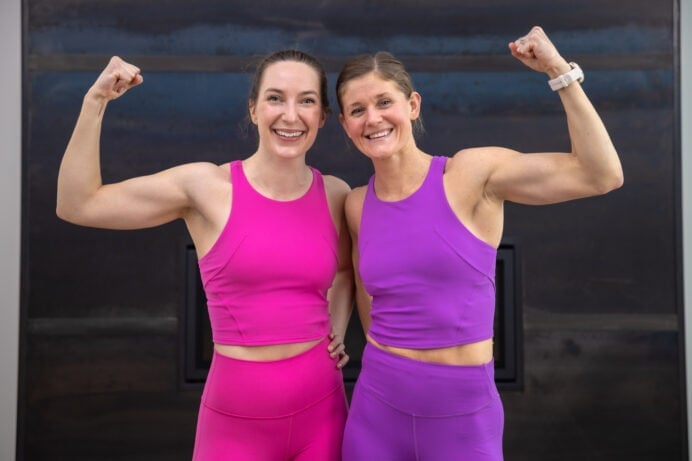

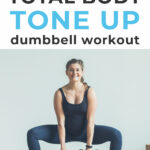
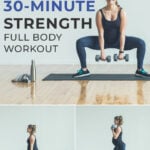
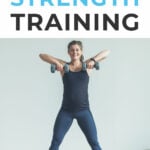
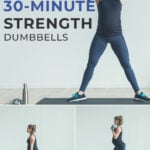


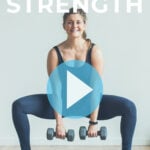
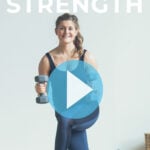
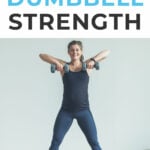

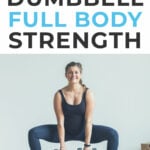
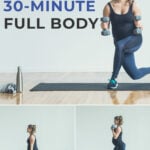
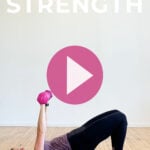
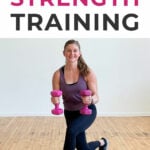
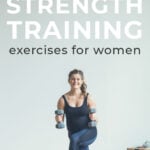
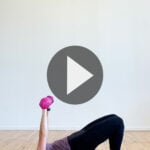
I was skeptical at first, as I’m used to my videos! Well…I’m sold! A solid 30 breathless, sweaty minutes! Thank you!!
Shaun! So glad you were willing to give this workout a try and liked it! It sure does give you a total body burn in 30 minutes! Thanks so much for sharing and I hope you Pin this one to your workout boards and come back for more! -Lindsey
Thank you SO much for sharing these simple moves/workouts Lindsay! I really like how simple you make them and how you incorporate movement into lifting weights.
Emily! I’m so glad you love these 7 exercises as much as I do! Thanks so much for your feedback and I hope you add this one to your ‘workout’ Pinterest board or weekly routine. Thanks Emily and have a great week, xo-Lindsey
Love this workout. I did it this evening. Quick and efficient! Love that sweater, too!
Laura! I’m so glad you love this workout as much as I do! And seriously I lived in that sweater during my second trimester, so cute + comfy! Thanks for sharing and awesome work! xo-Lindsey
I can’t wait to try this workout! I just found out I’m pregnant (yay!) and been reading a lot about exercising during pregnancy. Do you have any tips of what to focus on/avoid? I read that you should not do workouts on your stomach or back. Are these bridge workouts safe?
Sandi! Congrats on your pregnancy — that’s so exciting!!! Honestly, my best tip for exercising while pregnant is to listen to your body! If you’ve been active stick to your normal routine (it will help you feel more normal too) and just listen to your body, pull back and modify when needed. I didn’t really start adjusting my workout routine till around 20 weeks and I slowly started modifying and now in the third trimester I’m doing lots of modifying. But pregnancy is so different for everyone so just listen to your body (it will tell you what it likes and doesn’t), stay hydrated and just try and keep moving! I stopped doing exercises on my stomach after 12 weeks, but I still do some stuff on my back if it feels ok. The main thing with bridges on your back is more when you’re at the end of second/beginning of third trimester and you want baby to be head down and doing bridges can confuse babies positioning. Again your body will tell you what it likes and doesn’t like! Hope that helps and happy #fitpregnancy! xo-Lindsey